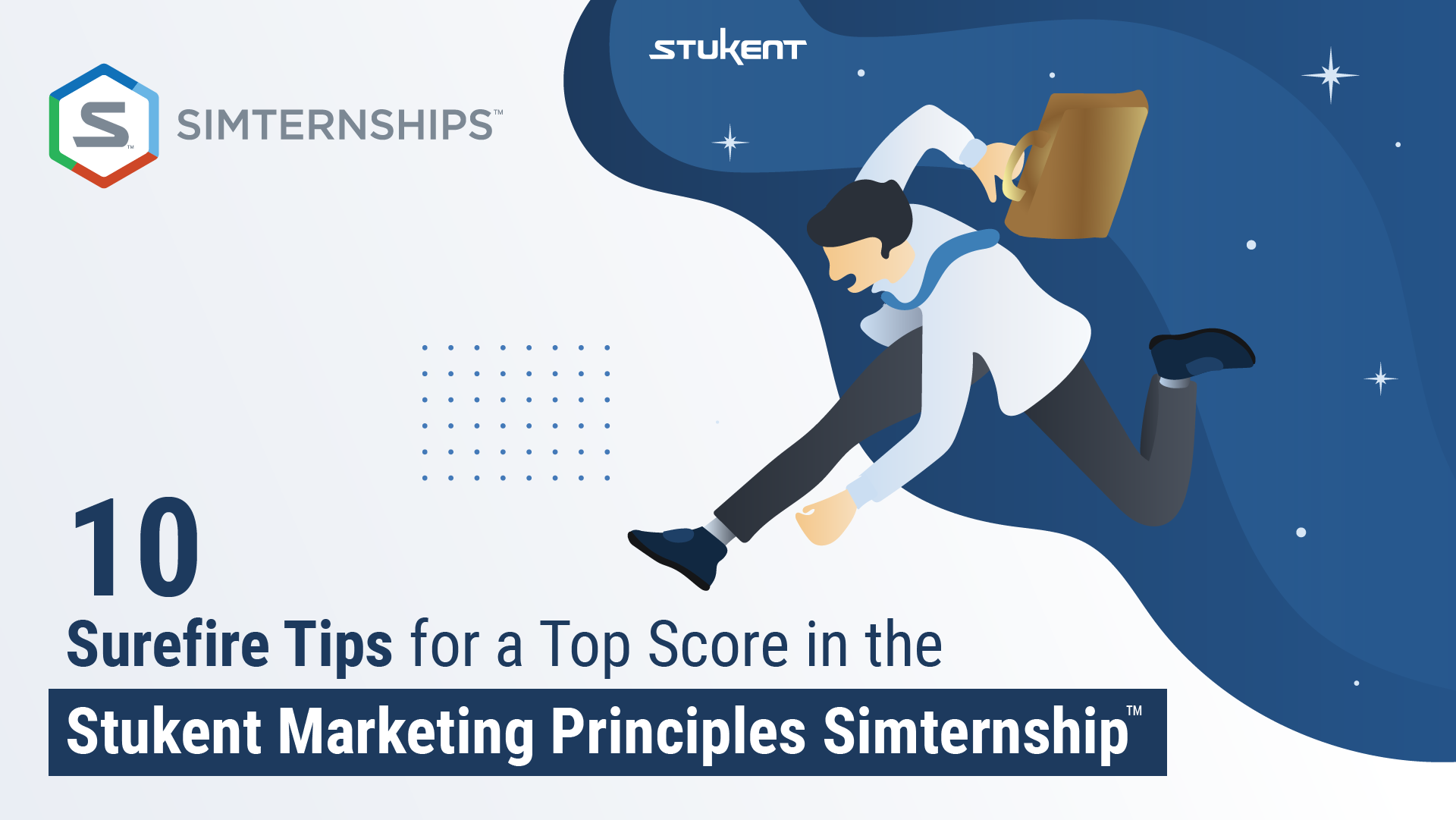It’s a question that has plagued students for generations: “How can I get a job in my chosen occupation when I don’t have any on-the-job experience?” Then comes the classic observation new hires often make when they finally DO land that coveted first chance to shine: “Wow, this is totally different from what I expected!”
That’s exactly what Stukent’s Marketing Principles Simternship™ does, and now you have an opportunity to take part in something students a decade ago needed — but didn’t have access to. The tips here will help you get ready, get set … and go prove to your professor and (most importantly) yourself that you have the chops necessary to be a real asset to any company fortunate enough to bring you on staff.
Tips to Help Excel in Stukent’s Marketing Principles Simternship™
1. Play for Keeps: Yes, this is a simulation. The company you’re “working for” during the simulation isn’t real, and nobody is going to lose money or get fired because of your decisions. If you approach it in that frame of mind, though, you’ll treat the simulation like a computer game. It will be fun, but not real. Remember this: Your need to expand your knowledge and capabilities IS REAL. This simulation and the experience you gain from it can mean the difference between getting the job or not getting the job, and starting a successful business or failing in business. It can provide insight you can draw on when the stakes are high and the impact of your choices matters to your team. Take this seriously. Play for keeps.
2. Know where you are: You may already be a competent marketer. Maybe you’ve already launched an online business of your own. Maybe you’re the person in class the other students turn to for advice. All of that won’t mean much when you’re given your first job assignment, though. You’ll need to prove yourself able to stand the heat. And you’ll be going up against marketing pros who know a whole lot more than you. Like the guitar player who headed to Music City to make a mark on the recording industry, you’ll find out that the competition is stiffer than you’ve ever imagined. The most productive attitude you can adopt is one you already have: Be a student. Find out everything you can about your company, the company’s customer base, the company’s philosophy, and the work you’ve been assigned. Do the same within the simulation. Act as if you’re actually on the job making critical decisions. Study the information provided in the memos and directions carefully. Don’t make a move until you know where you are.
3. Don’t rush. The simulation isn’t a race. It’s not a “see who can get finished first” contest. Keep Stephen Covey’s “sharpen your axe first” principle in mind. You’ll get considerably more accomplished if you take time to do the prep work first. Once you’re sure you know where you are, what your job position and assignment are, and which information will be most important to your success — then push the Run Simulation button. But not before. As you proceed through the simulation, resist the urge to fly through the process by making decisions based on your “gut feeling.” Use the market research you’ve gathered. Base your decisions on the data you’ve collected, not on what you think is best. That’s one of the biggest lessons a marketer can learn. We’ve a tendency to embrace the fallacy that others must think exactly like we think. The truth is … they often don’t. Don’t rush.
4. Stay focused on your target market. If this sounds like an amplification of the “biggest lesson” tip just covered … that’s because it is. There are enough stories to fill a “What not to do” encyclopedia about recent college graduates trying to force the market to want what they want rather than to give the market what the market wants. Get to know your target market. Many companies create detailed personas to describe their primary customers. Some even draw or clip images of those people and ask marketers to post them in conspicuous places. Designing and selling a product that will appeal to guys 20 years old and under who live in the USA and love to play video games, for example, will likely take a much different route than doing the same work for a target market of women in their 40s who hold executive positions in business. Don’t fall for the fallacy of “everyone wants what I want.” Stay focused on your target market.
"Focusing on your target demographic when selecting the bag you wish to sell and figuring out what appeals to the majority of those people is key to being successful."
Zach Nelson - Student
5. Ask the right questions. One of your first tasks in the simulation is to select the questions for a market survey. Scan the list of available questions first to get a feel for what is possible. Then refer to the guidelines given for making your selections. You want to know about the features your target audience prefers, the price level they are comfortable with, where they are seeing ads for your product now, and what promotions and charities they are most interested in. You want your survey to be as relevant as possible, and you want the data you collect to help you hone in on the right product, the right price, the right promotion, and the right social platform to reach and appeal to your target audience. You’ll be most successful when you ask the right questions.
6. If you get lost, retrace your steps. Should you get confused along the way, go back to a point where you were clear and confident. Review the feedback received from previous rounds, and dig back into the research findings you paid for. If you need to ask for help, that’s okay … but first make sure you really are stuck. Your on-the-job supervisor will expect you to keep moving forward without constantly needing help. If you get lost, retrace your steps. You’ll learn much more like that, and you’ll gain confidence in your abilities.
"What is going to happen if you make a mistake early on? I chose a bad design for my tote bag, and that is why my revenue was low at product launch. However, it was possible to improve along the way and increase revenue with the right decisions in pricing, ad spending, promotion, pricing, and product distribution. This is a very crucial point, and it helps students to make up for a mistake early on in the simulation."
Markus Kopp - Student
7. You have to spend money to make money. You’ll have access to $5,000 of marketing department funds to accomplish your mission. Saving $1,000 of that by cutting corners isn’t going to impress your boss … but getting stellar results will. Market research is a major part of marketing. That’s because you really don’t know what the market wants until you’ve done the research, launched your product or service, then crunched the data from your results. We’ll say it again: Everybody isn’t just like you. Stay in marketing long enough, and you’ll discover that even people your own age don’t always like what you like. Use your budget, but use it judiciously. You have to spend money to make money.
8. Price your product according to your market. This is another huge lesson marketers eventually learn. Not only does everyone not want what you want, they don’t spend what you spend on the things you both want. Some people think a shirt from Walmart is overpriced if it’s more than $15. Others wouldn’t dream of shopping for clothes at Walmart and won’t buy a shirt priced LESS than $95. Find out what your target market wants, then give it to them. Don’t base your decisions on your own preferences, consult the research data you purchased and check your feedback from prior rounds. This will help you price your product according to your market.
"I like that the simulation required a lot of analysis. I had to clearly understand my results, what I was aiming for, what happened in the round before and what improved after in order to improve on the next round. I also like the fact that you could not go back to change what you chose."
Dayana Castaneda Morales - Student
9. Listen carefully to feedback. You’ll get feedback from a number of sources. Seek out all the advice you can get. Consult the practical wisdom readily available in the “Modern Marketing Principles” digital textbook and videos. Listen to your professor and definitely, definitely, definitely … listen to the results you’re getting. Wise people seek counsel and temper their decisions with it. Foolish people hate getting advice and always think their way is best. Which do you think is the best attitude for getting started in online marketing? Many others have walked the path before you. Honor their input and listen carefully to feedback.
10. Every mistake is a learning opportunity. Don’t get defensive. Don’t blame the simulation or your professor for poor or unexpected results. Your outcomes depend largely on your decisions. The good news is that even your erroneous choices can be tempered and corrected. Keep your “I’m a student” stance going even after you’ve graduated, even after you’ve landed that first job, and even after you’re promoted to a management position. In the school of life, you’ll learn many, many lessons. Don’t despair when things don’t seem to be going your way. Find out why and make necessary corrections in your approach. Setbacks are setups for success when you know that every mistake is a learning opportunity.
Formerly known as Mimic Marketing Principles.






